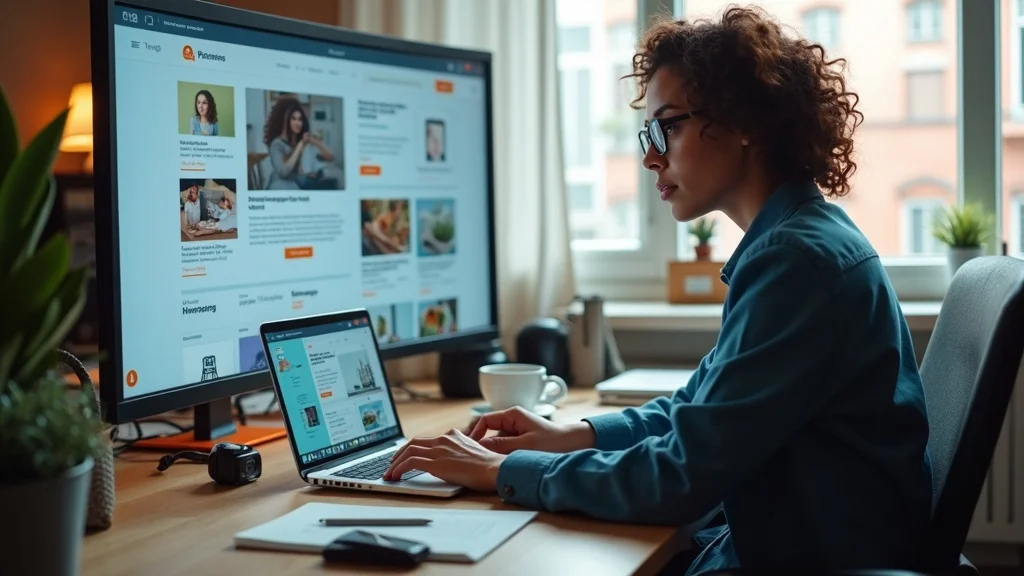Did you know that paid website traffic can drive a 10x faster increase in site visits compared to organic methods? In the highly competitive digital marketplace, small businesses can’t afford to wait months for results. Unlocking targeted, rapid website traffic is now essential to growing your brand, generating leads, and outpacing your competitors. This comprehensive guide reveals exactly how business owners and marketing professionals can use paid traffic strategies—from precise programmatic campaigns to Google Ads and social media—to put their offers in front of the right customers instantly.
Driving Paid Website Traffic for Small Businesses: The Fastest Path to Targeted Visibility
"Targeted paid website traffic is the fuel for online growth, delivering your message directly to the prospects that matter most."
For small businesses eager to make an impact online, the biggest challenge is standing out and reaching ideal customers—without waiting months for organic growth. Paid website traffic for small businesses provides an immediate way to guarantee your brand, services, or products are showcased to your target audience the moment a campaign launches. This approach offers the highest level of control over who sees your business and when, eliminating guesswork and wasted marketing budget. By leveraging paid ads across traffic sources such as Google Ads, social media, and advanced programmatic marketing, business owners can increase website traffic fast and connect with motivated buyers at every stage of the purchase journey.
The key advantage of paid website traffic is its precision targeting—you decide the demographics, locations, interests, and even devices your ads appear on. This level of customization ensures every marketing penny is directed at prospects most likely to convert, boosting your return on investment (ROI). Companies in bustling regions like Greater London, UK have seen remarkable success using Capid Houser’s tailored paid traffic strategies—achieving instant visibility, higher engagement, and measurable growth. In an environment where timing and relevance mean everything, paid advertising hands you the steering wheel.

What You'll Learn About Paid Website Traffic for Small Businesses
- The fundamentals and benefits of paid website traffic for small businesses
- Key paid traffic sources: search engines, social media, and programmatic marketing
- Steps to set up a high-converting landing page
- How to use Capid Houser's programmatic marketing service
- Ways to leverage complementary digital marketing services for holistic growth
- Real-world examples spanning Greater London, UK companies
Understanding Paid Website Traffic for Small Businesses
Why Paid Traffic Matters for Website Traffic and Business Growth
In today’s crowded digital arena, paid website traffic isn’t just a luxury—it's a business necessity. With organic reach declining and competition intensifying, waiting for slow, incremental growth from organic traffic can leave your business lagging behind. Paid traffic sources, by contrast, deliver a steady stream of quality traffic instantly—meaning every pound or dollar spent yields actual website visits from your ideal prospects. This immediacy is crucial for small business owners who need fast results to support launches, promotions, or seasonal campaigns.
Another game-changing benefit is measurability. With tools like Google Analytics, you track exactly where your traffic originates, which ads convert best, and how users interact on your landing page. Real-time insights empower you to refine your marketing campaigns on the fly, maximizing ROI and minimizing wasted spend. Especially for companies seeking to increase their website traffic quickly in competitive markets like London, the combination of speed, precision, and data-driven decision making that paid traffic offers is unrivaled.

The Difference Between Organic Traffic and Paid Traffic Sources
While both organic traffic and paid traffic contribute to your digital presence, the method, speed, and control they offer differ significantly. Organic traffic relies on search engine rankings gained through content, SEO, and time-consuming reputation-building. It generally costs less in the long run but can be unpredictable and slow to ramp up—especially for new domains or markets. Paid traffic sources, such as Google Ads, social media, and programmatic ads, let you buy targeted visibility—appearing instantly in search results, newsfeeds, or premium banner spaces based on your chosen criteria.
For small businesses seeking an immediate edge or targeting a specific customer base, paid advertising is the go-to solution. It allows you to bypass the long queues of search engine algorithms and directly access your audience. While paid campaigns require an investment, the ability to control every variable—from traffic source to conversion funnel—enables smarter budgeting and predictable outcomes. Integrating both strategies is ideal for sustained success, but if speed is crucial, paid website traffic is unbeatable.
The Anatomy of Traffic Sources for Small Businesses
Navigating today’s digital landscape means understanding the distinct traffic sources available to small businesses. Choosing the right source determines how effectively you drive traffic to your website and achieve your business objectives. Here are the most impactful channels for paid website traffic:
- Search Engine Marketing (Google Ads)
- Social Media Advertising
- Programmatic Marketing
- Native and Display Ads
- Remarketing Campaigns
Search engine platforms like Google Ads offer unrivaled intent-targeting by displaying your paid ad only to users actively searching for services you offer. Social media advertising excels at building awareness and engagement thanks to intricate demographic targeting and creative ad formats. Programmatic marketing takes targeting to the next level—using real-time bidding and data on user behavior to place your banners exactly where your target market is browsing, be it on desktop, mobile, or in-app. Native and display ads enable you to visually showcase your brand across the web, while remarketing keeps your offers top of mind for visitors who didn’t convert on the first visit.
Selecting the Right Traffic Source for Your Small Business
Not all traffic sources are made equal—and choosing wisely can make or break your website traffic strategy. Assess your objectives: Are you seeking quick leads, driving brand recognition, or nurturing long-term customer relationships? For most small businesses, a blend of search engine, social media, and programmatic paid ads provides the best balance of reach, control, and ROI.
Programmatic marketing, for instance, is ideal for companies with defined customer personas, as it leverages advanced data—including location, interests, and device usage—to ensure your paid banner appears at exactly the right time. If you aim to drive traffic for a product launch, Google Ads delivers high conversion intent. For awareness in a local market, such as Greater London, geo-targeted display ads or sponsored social media posts deliver exceptional outcomes. The goal: source quality traffic, minimize bounce rate, and boost conversions.
| Traffic Source | Cost | Reach | Effectiveness | Targeting Options | Bounce Rate Impact |
|---|---|---|---|---|---|
| Google Ads (Search Engine) | Moderate–High | Global & Local | Very High (intent-based) | Keyword, Location, Demographics | Low–Moderate |
| Social Media Ads | Low–Moderate | Large, Highly Targeted | High (engagement-based) | Interest, Age, Behavior, Location | Moderate |
| Programmatic Marketing | Flexible | Global, Multi-Platform | Very High (data-driven) | Demographics, Interests, Contextual, Geo | Low |
| Display/Native Ads | Variable | Massive | Moderate–High | Context, Site Category, Device | Moderate–High |

Introducing Programmatic Marketing for Paid Website Traffic Growth
How Programmatic Marketing Delivers Precise Targeting for Website Traffic
Programmatic marketing revolutionizes how small businesses approach paid traffic. Unlike traditional media buying—where you negotiate with publishers—programmatic uses sophisticated AI and real-time bidding to purchase ad space instantly wherever your audience is online. This means your banner ads reach specific individuals based on rich data, such as location, browsing habits, interests, and device type. For example, a local retailer in Greater London can set campaigns so that only shoppers within a set radius, interested in their category, see their offer on multiple platforms.
With partners like Capid Houser (learn more at programmatic marketing services), you don’t need to be a tech expert—your campaigns are expertly configured to make sure your ads appear to the right user, at the right moment, wherever they’re active online. This agility gives small businesses an enterprise-grade edge, ensuring every penny delivers quality traffic with high intent, dramatically increasing your website’s conversion potential.
Benefits of Programmatic Banner Display Campaigns for Small Businesses
"With programmatic marketing, your brand's banners reach the right people at the right time, across devices and platforms — wherever your prospects are."
The real advantage of programmatic display campaigns lies in scalability and efficiency. Ads are automatically optimized for performance, continuously learning from user interaction data and adjusting in real time. This drastically minimizes lost spend, reduces bounce rates, and ensures you’re investing only in channels that prove effective. Campaigns can be instantly paused, scaled, or refined, providing business owners with precise control.
Moreover, since programmatic covers multiple channels, platforms, and devices—including mobile, tablet, and desktop—you achieve seamless, cross-platform visibility. For London small businesses aiming to reach every potential customer wherever they are—at work, at home, or on the move—this flexibility is invaluable. With Capid Houser’s programmatic expertise, even companies new to digital marketing can harness the power of advanced audience targeting at an affordable, transparent cost.

Step-by-Step: Launching a Paid Website Traffic Campaign for Small Businesses
Defining Your Offer and Creating a High-Converting Landing Page
- Crafting compelling headlines and copy
- Design principles for landing pages
- Essential call-to-action strategies
- Incorporating trust signals and reviews
Every effective paid website traffic campaign starts with a clear, irresistible offer presented on a purpose-built landing page. Unlike your homepage, a landing page is designed to do one thing: convert visitors into leads, inquiries, or customers. The success of even the most well-targeted paid ad depends on the quality of this destination. Pages should feature attention-grabbing headlines that state the benefit up front, concise and persuasive copy that addresses the visitor’s needs, and a prominent call to action (CTA) such as “Book Now,” “Get a Free Quote,” or “Buy Today.”
Sound design principles—clear layout, mobile responsiveness, fast load times, and minimal distractions—reduce friction and keep the focus squarely on conversion. Incorporate trust signals like client reviews, ratings, or logos of recognizable partners, and reinforce them with clear privacy policies and secure checkout badges. Capid Houser’s content marketing and business review services can help populate your landing page with powerful, conversion-boosting testimonials and professionally written copy that drives results.
Setting Up Paid Ad Campaigns for Website Traffic (Google Ads, Social Media, Programmatic Platforms)
With your landing page ready, it’s time to build, launch, and manage a high-impact paid ad campaign. Start by defining your campaign goal, whether that’s getting phone calls, online purchases, sign-ups, or downloads. Within Google Ads, select the campaign type (Search, Display, or Smart), set geographic and demographic targeting, choose relevant keywords, and write compelling ad copy that matches your landing page incentive. For social media ads, platforms like Facebook and LinkedIn offer robust audience filters, including interests, job roles, and behavior patterns—ideal for B2C and B2B lead generation alike.
For ultimate reach, Capid Houser’s programmatic marketing solution uses advanced software to automate your bids, continually optimize placements, and allocate your budget to ad networks and sites with the best performance. Test multiple creatives, monitor click-through rates, and adjust your strategy based on what’s driving quality website traffic and conversions. Setting daily or weekly budgets—and refining based on actual campaign data—puts you fully in control of spend and ROI.

Tracking and Benchmarking Website Traffic with Google Analytics
Ongoing measurement is the oxygen for every paid website traffic campaign. Google Analytics helps you pinpoint which ads or traffic sources are driving the most valuable behavior—such as filling out forms, making purchases, or spending time on key site pages. Set up goals and conversion tracking, compare performance across channels (Google Ads, programmatic displays, social media), and carefully watch metrics like bounce rate (the percentage of visitors who leave quickly), average time on site, pages per visit, and—in particular—the conversion rate.
Benchmark your data regularly and use these insights to continually refine your campaigns. For instance, if you’re seeing high bounce rates from certain display ads, consider reviewing your landing page’s relevance to the ad’s message. If conversions from programmatic marketing outperform social media, adjust your budget accordingly. By partnering with Capid Houser, you gain access to expert campaign managers who’ll help you make sense of the numbers and pivot quickly for consistent growth.
Case Study: How Greater London, UK Small Businesses Drive More Traffic to Your Website
Targeting Local Prospects and Market Segments with Paid Website Traffic Strategies
- Utilizing local SEO with paid traffic
- Geo-targeted display and banner ads
- Leveraging programmatic for niche audiences
For small businesses in densely populated, hyper-competitive areas such as Greater London, generic campaigns are rarely enough. Instead, the most successful companies deploy a blend of local SEO and paid website traffic strategies to target prospects on their doorstep. Capid Houser clients, for example, combine Google My Business optimization with geo-targeted banners and programmatic ads that only display for users in relevant London postcodes or boroughs—dramatically improving campaign efficiency and reducing wasted spend.
This laser-targeted approach means marketing budgets go further and response rates are far higher. For a local bakery, for instance, programmatic campaigns can deliver mouthwatering offers to mobile users within walking distance at key times of day, while regional tradespeople can use remarketing and display ads to get more repeat business from known customers. These real-world examples showcase how paid website traffic can help highly specialized, local, or niche businesses get found by exactly the right audience—faster than ever before, and with measurable ROI.
"Paid website traffic strategies put Greater London businesses in front of the exact customers seeking their offers, faster than ever before."

Maximizing Results: Combining Paid Website Traffic with Other Digital Marketing Services
How Google Business Review Grams Amplify Paid Traffic Campaigns
It’s not just about driving more visitors; it’s about maximizing the impact of every website visit. By integrating Google Business Review Grams—which lets you share glowing client testimonials directly to your social feeds and across your website—you instantly build trust and credibility. Visitors arriving via paid traffic sources are more likely to convert when they see fresh, positive reviews that reinforce your offer.
Capid Houser’s platform automates this process, making it simple to collect and showcase user feedback. Because reviews are critical for local SEO as well, the synergy between paid campaigns and review marketing generates even more quality traffic and helps you dominate local rankings. The end result? Every paid ad not only attracts more clicks, but also brings in prospects who are already warmed up by authentic social proof.

Reputation Management & Content Marketing: Enhancing Paid Website Traffic Conversions
To get the best ROI from paid website traffic for small businesses, invest in your reputation and messaging. Capid Houser’s reputation management and content marketing services help you own your story, counter negative feedback, and produce high-value articles, videos, and case studies that keep your business top of mind.
When visitors reach your landing page via a paid ad, well-crafted, relevant content encourages engagement and trust, while proactive reputation management means negative reviews or misinformation don’t sabotage your conversion rates. Cohesively, these complementary digital marketing strategies ensure that every click counts—and every customer journey ends in a positive outcome.
Virtual Office Telephone Answering and Chatbot Marketing for Small Businesses
Modern paid advertising should align with seamless support and communication. Capid Houser provides virtual office telephone answering and chatbot marketing designed for small businesses who want to respond instantly to leads who land on their site from paid ads. No missed calls, no lost opportunity—clients engage with live operators or advanced chatbots at any time of day.
These services not only boost conversion rates directly but also improve visitor experience and trust, further leveraging the value of every traffic source. Combined with targeted campaign strategies, this digital support ecosystem gives business owners peace of mind and consistently better outcomes from their paid website traffic investments.

Key Performance Metrics: How to Measure Paid Website Traffic Success
- Click-through Rate (CTR): How many users click your ad versus impressions
- Conversion Rate: How many clicks result in leads or sales
- Bounce Rate: How often visitors leave the site after one page
- Cost per Acquisition (CPA): Your spend per new customer or goal
- Quality Traffic vs. Total Visits: Are you attracting engaged, relevant visitors?
Success in paid website traffic campaigns goes beyond sheer visitor volume. Quality traffic—those visitors most likely to convert—trumps quantity every time. Begin with CTR analysis to see which ad creatives attract attention. Conversion rate measurement tells you which ads, keywords, or platforms yield actual business value. High bounce rates may signal poor ad/page matches or a need to refresh landing page content. Keep a close eye on CPA to ensure your campaigns remain profitable, and segment Google Analytics reports to distinguish between casual browsers and valuable, engaged prospects.
| Channel | Sessions | CTR (%) | Conv. Rate (%) | Bounce Rate (%) | CPA (£) |
|---|---|---|---|---|---|
| Google Ads | 1,500 | 3.2 | 12.5 | 40 | 14.00 |
| Programmatic | 900 | 4.8 | 15.2 | 28 | 11.70 |
| Social Media | 1,200 | 2.7 | 9.1 | 52 | 17.50 |
People Also Ask: Paid Website Traffic for Small Businesses
How much will a small business pay for a website?
Answer: The price for a small business website can range from a few hundred to several thousand pounds, depending on complexity. Ongoing paid website traffic campaigns are generally priced based on daily ad spend and service fees.
What is the best paid traffic for a website?
Answer: The best paid traffic source for a website depends on the target audience and campaign objectives—for most small businesses, programmatic marketing, Google Ads, and social media advertising offer strong results.
What is the average traffic for a small business website?
Answer: The average small business website receives between a few hundred and a few thousand monthly visits, but paid website traffic efforts can rapidly increase these numbers, especially with targeted campaigns.
Can you get paid for website traffic?
Answer: While businesses invest in paid website traffic to attract visitors, website owners with significant traffic can monetize visits through ads, affiliate marketing, and sponsored content.
FAQs: Essential Insights on Paid Website Traffic for Small Businesses
-
How quickly can paid website traffic deliver results for small businesses?
Paid website traffic can start driving significant, relevant visitors within hours of campaign launch, especially when leveraging programmatic or Google Ads solutions. -
What budget is needed to start a paid traffic campaign?
Starting budgets can be as low as £5-£10 per day, though results scale with increased investment and platform selection. -
How does targeting differ with programmatic vs. traditional paid ads?
Programmatic marketing uses in-depth data and AI for audience targeting—location, interests, behaviors—while traditional paid ads often center around keywords and broad demographics. -
Can paid traffic strategies work for niche or local businesses?
Absolutely. Geo-targeting, industry segmentation, and device-level targeting empower local and niche businesses to reach only their most valuable prospects. -
Do paid website traffic campaigns impact SEO?
While paid campaigns don’t directly influence SEO rankings, increased site visibility and traffic can lead to more engagement, reviews, and backlinks, indirectly supporting SEO growth.
Key Takeaways for Paid Website Traffic for Small Businesses
- Paid website traffic is the fastest way for small businesses to gain online visibility.
- Programmatic marketing offers unmatched targeting—by location, device, and interest.
- Combining digital marketing services amplifies the ROI of paid traffic campaigns.
- Regular analysis of campaign performance is essential for sustainable growth.
- Capid Houser is a trusted partner for companies in Greater London and beyond.
Begin Your Paid Website Traffic Journey Today
Contact us at https://www.capidhouser.com/paid-website-traffic/ to kickstart your Paid Website Traffic campaigns
Ready to increase your website traffic fast? Unlock the power of paid website traffic for small businesses—combine advanced digital marketing, expert support, and proven results to fuel your growth now!
 Add Row
Add Row  Add
Add 




Write A Comment